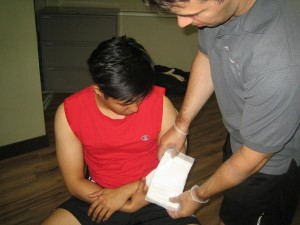
Preventing infection in the community is one of the primary goal of health care workers designated in the care of a community of people. The local as well as the state public health departments share this responsibility of maintaining and safeguarding the health of people by setting guidelines and policies of healthful practices to be adopted by people in order to limit the incidence if not fully prevent communicable disease and infection from spreading within a community.
Methods of preventing infection include proper sanitation techniques, regulated health practices, proper disposal of sewage and more importantly an effective immunization program made accessible by the local health department to the local community. The main objective of these infection prevention strategies is basically to avoid the onset and the spread of infection through health information dissemination of effective health practices and immunization programs to further augment the health of individuals living within a community.
Preventing infection through vaccination programs
The goal of vaccination programs is to use wide-scale efforts to prevent infection and infectious diseases from spreading in a given population or community. Public health decisions regarding vaccination campaign implementation efforts tend to be complex. The risks and benefits for the person and the community must be evaluated in terms of morbidity, financial costs and benefits. The most successful vaccine programs have been those for the prevention of smallpox, measles, rubella, polio, diphtheria, tetanus and pertussis. During the last decade, there were growing concerns over the possibility that the smallpox virus could be reintroduced as a biological weapon which led to the decision that emergency medical responders and selected health care workers should be vaccinated against the smallpox virus.
Incidence of vaccine preventable diseases and preventing infection
The incidence of vaccine preventable diseases such as measles mumps, rubella and diphtheria is greatly affected by immigration from developing countries to developed countries. The reason for this is that unlike most developed countries such as the United States wherein vaccination programs are mandatory, vaccination campaigns and programs of the former are often met with financial and logistical constraints, hence immigrants from these areas tend to be unprotected and not immune from certain diseases. Individual risk and epidemic risk are reduced when vaccination programs and campaigns are easily accessible to the high population especially those immigrants who are densely concentrated in a particular community.
Preventing infection and contraindication to vaccines
Individuals who have developed encephalopathy within seven days of a previous diphtheria, pertussis and tetanus dose (DPT) as well as
those who have developed anaphylaxis or other moderate or severe sequalae after a previous dose should not be given further doses of immunization as it may further aggravate the initial untoward reactions to the preliminary dose of the vaccine. Moreover, live vaccines usually are contraindicated for patients or close contacts of patients with severe immunosuppression such as HIV-AIDS, leukemia, lymphoma, generalized malignancy, significant corticosteroid use and immunosuppressive medications. Preventing infection through vaccination is therefore highly contraindicated on the prior mentioned instances since the induction of live attenuated vaccines could exacerbate an individual’s already compromised immune response.
